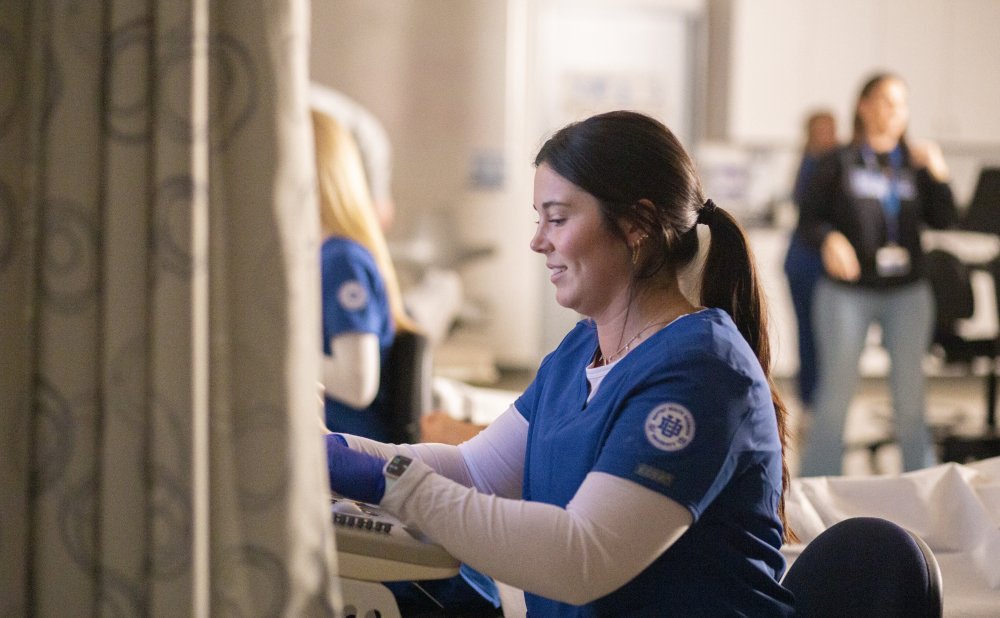Answering the Top 3 Google Searches About Sonography

Every day, people turn to Google to learn more about sonography—what it is, how to enter the field, and whether it’s a good career. In honor of Medical Ultrasound Awareness Month, we’re answering the top three most common questions with expert insight from Connie Willis, MS, RDMS, RDCS, RVT, Program Chair of Diagnostic Medical Sonography at Baptist Health Sciences University.
1) What is sonography and what do sonographers do?
Sonography, also known as diagnostic medical ultrasound, is a non-invasive imaging technique that utilizes high-frequency sound waves to create detailed images of organs, tissues, and blood flow inside the body.
Sonographers are highly trained health care professionals who operate ultrasound equipment to capture accurate diagnostic images that physicians use for diagnosis. They work with doctors and other members of the health care team to evaluate a wide range of medical conditions.
Being a sonographer means playing a vital role in healthcare, where every day you have the opportunity to profoundly impact patients’ lives. By combining advanced technical skills with genuine compassion, sonographers deliver essential diagnostic insights that can shape treatment decisions and patient outcomes.
— Connie Willis, MS, RDMS, RDCS, RVT
In addition to their technical expertise, sonographers work directly with patients, explaining procedures, ensuring patient comfort, and maintain a compassionate environment throughout the examination process.
2) How do you become a sonographer?
Education
To pursue a career as a sonographer, individuals complete an accredited educational program in Diagnostic Medical Sonography, which typically consists of either:
- a two-year associate degree, or
- a four-year bachelor’s degree.
These programs include comprehensive classroom instruction in areas such as anatomy, physics, and patient care.
Clinical Training
Alongside coursework, students complete supervised clinical training in health care settings such as hospitals or clinics.
This hands-on experience ensures proficiency in both theoretical knowledge and practical scanning skills.
Graduation
After completing the program, students graduate and are considered eligible to move into the profession—but one more critical step remains.
Certification
Upon graduation, earning professional certification is strongly advised and often required by employers.
Recognized certifying bodies include:
- ARDMS (American Registry for Diagnostic Medical Sonography)
- CCI (Cardiovascular Credentialing International)
- ARRT (American Registry of Radiologic Technologists)
To earn certification, graduates must:
- Pass a rigorous exam
- Complete ongoing continuing education to maintain credentials
This demonstrates a commitment to professional excellence and patient care.
3) Is sonography a good career?
Yes, sonography is a rewarding and in-demand career.
According to the U.S. Bureau of Labor Statistics, the demand for diagnostic medical sonographers is growing faster than average compared to other professions.
In the United States, annual salaries for sonographers typically range from $60,000 to $90,000, depending on factors like experience, location, and specialization.
But, beyond financial incentives, a career in sonography is highly rewarding due to the significant impact sonographers have on patient care. These professionals play a crucial role in the diagnostic process, assisting physicians in the detection and management of medical conditions.
They also work in collaborative health care environments, contributing both technical expertise and compassion to improve patient outcomes.
At Baptist Health Sciences University, we are proud to educate the next generation of sonographers who combine skill, technology, and heart.
Explore the Diagnostic Medical Sonography program at Baptist University.





